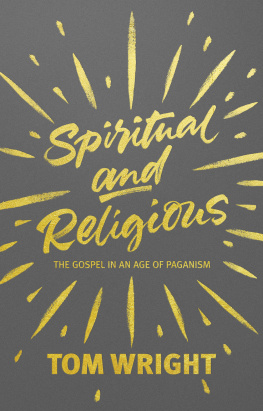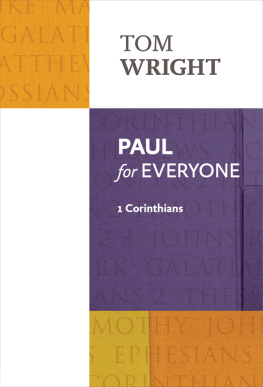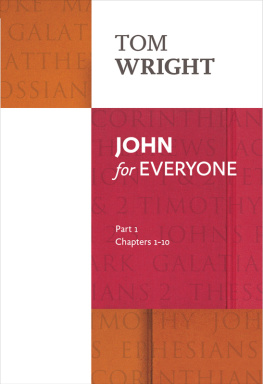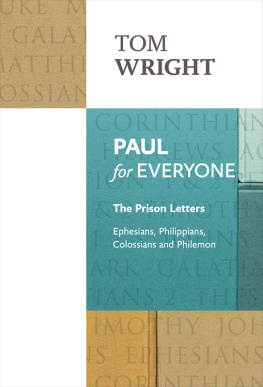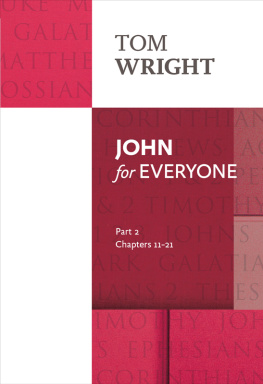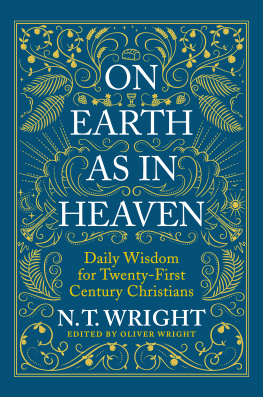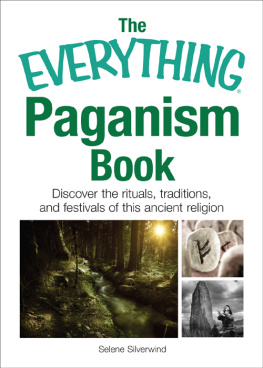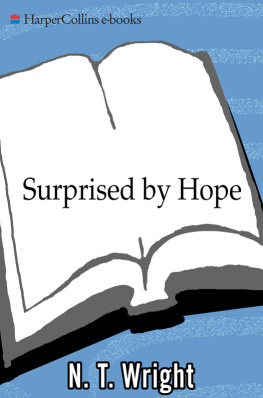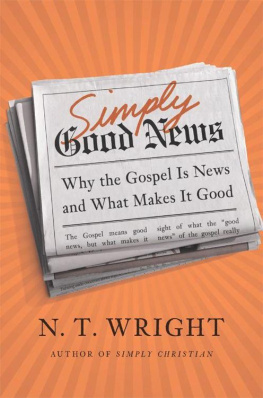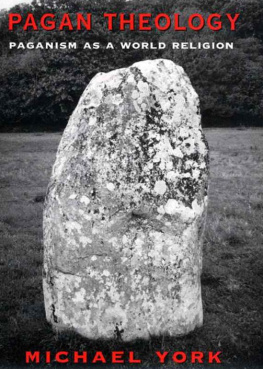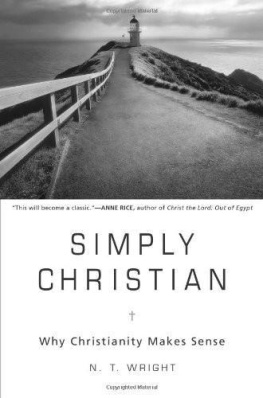


First published in Great Britain in 1992
as New Tasks for a Renewed Church by
Hodder & Stoughton
This edition published in Great Britain in 2017
Society for Promoting Christian Knowledge
36 Causton Street
London SW1P 4ST
www.spck.org.uk
Copyright Nicholas Thomas Wright 1992, 2017
All rights reserved. No part of this book may be reproduced or transmitted in any form or by any means, electronic or mechanical, including photocopying, recording, or by any information storage and retrieval system, without permission in writing from the publisher.
SPCK does not necessarily endorse the individual views contained in its publications.
Scripture quotations from the Old Testament marked NRSV are taken from the New Revised Standard Version of the Bible, Anglicized Edition, copyright 1989, 1995 by the Division of Christian Education of the National Council of the Churches of Christ in the USA, used by permission, all rights reserved; those marked RSV are from the Revised Standard Version of the Bible, copyright 1946, 1952 and 1971 by the Division of Christian Education of the National Council of the Churches of Christ in the USA, used by permission, all rights reserved; those marked TEV are taken from the Good News Translation in Todays English Version. Second edition copyright 1992 by American Bible Society, used by permission.
Scripture quotations from the New Testament are reproduced from the authors own translation, The New Testament for Everyone, copyright Nicholas Thomas Wright 2011.
Every effort has been made to seek permission to use copyright material reproduced in this book. The publisher apologizes for those cases where permission might not have been sought and, if notified, will formally seek permission at the earliest opportunity.
British Library Cataloguing-in-Publication Data
A catalogue record for this book is available from the British Library
ISBN 9780281072842
eBook ISBN 9780281072859
Typeset by Lapiz Digital Services
First printed in Great Britain by Ashford Colour Press
Subsequently digitally printed in Great Britain
eBook by Lapiz Digital Services
Produced on paper from sustainable forests
Contents
Part 1
THE MODERN WORLD AND THE
CHRISTIAN MESSAGE
Part 2
ON BEING THE CHURCH FOR THE WORLD
Preface
The challenges facing todays church often seem insuperable. Those of us who grew up in the UK when churchgoing was still relatively fashionable have watched attendances dwindle, have heard the media laughing at Christians and their beliefs, and have seen Christian values thrown overboard in public life. The same thing has been happening in other parts of the Western world, albeit more slowly in the USA. We know that the church is expanding in the so-called developing countries, but that only makes some commentators sneer at the naivety of such unenlightened societies. In place of an earlier faith, many forms of paganism are now on the rise. It is as well for Christians to be realistic about their present embattled situation. Two things, however, have to be remembered. First, the early church faced a pagan world far more powerful and entrenched than ours. The gospel of Jesus was born into a world where its central claims were laughed out of court. The message of the crucified Messiah was, as St Paul put it, a scandal to Jews and madness to non-Jews. The wider world was neither expecting nor wanting the kind of news that the early Christians were proclaiming. They already had their own well-developed culture, complete with their own gods and goddesses. Paganism was an entire way of life. Its religion the worship of the many deities of the ancient world, and the practices that went with that was simply one way of expressing graphically what human life was supposed to be all about. Our challenges are as nothing to the ones faced by the first Christians. Welcome (they might say) to the normal Christian world.
Second, as the early Christians thought through their faith they saw the death and resurrection of Jesus as the victory of the true God over all the powers of the pagan world. This was paradoxical, to say the least. The pagan world went on persecuting and killing them. But the lived-out message of the gospel made its way none the less. Indeed, the courage of Christians facing torture and death, and above all the love which they showed to one another and even to their persecutors, made people realize that they were embodying a new way of being human. A way which reflected a true God, totally unlike the gods and goddesses the world had known before. So when we go back to the first Christians, and especially the writings of the New Testament, we find a message which fits our own times as much as theirs. If we face a resurgent paganism, we face it with the same assurance of victory as our forebears had.
The present book is written to draw attention to the ways in which various forms of paganism have once again become prominent in our world and to suggest that, when we look at certain things that have been going on in the church, we dont merely see worrying indications of decline; we see exciting signs that God is doing new things. My overall proposal is that the true and living God has been equipping the church in a variety of ways, ways which seem expressly designed to enable us to meet the new challenges we now face.
One way in which this challenge is often posed can be seen when people say that they are not religious, but that they are, in some way, spiritual. By not religious they usually mean that they dont go to church, dont regularly pray, and almost certainly dont read the Bible. But when we look more closely at the way our contemporary world actually works we discover, as we see in this book, that todays society is in fact very religious. The signs of this the worship of Mammon (the god of money), Aphrodite (the goddess of erotic love), Mars (the god of war or violence) and many other deities are engrained in the way we think, in the assumptions we make about how life works. When people in this world say they are spiritual what they often mean is that they are aware of spiritual dimensions in their lives (perhaps glimpsed in art or music). There are fewer closed-minded materialists around than there used to be. But the spiritualities of todays world often belong, not with the Jewish or Christian traditions, but with the new paganisms themselves. Todays world is spiritual and religious, even if both those terms are slippery and easily misunderstood.
The Christian approach to this world, like the early Christian approach to the paganisms of late antiquity, is rooted in the biblical story, focused especially in the story of Jesus himself. The first half of this book therefore follows the double pathway of exploring the world of paganism on the one hand and the story of Israel, with its focus on Jesus and his death and resurrection, on the other. This half of the book follows the journey which many Christians take in Lent each year, starting with Ash Wednesday, a time of reflection and penitence, and moving on to stand at the foot of the cross on Good Friday.
The second half of the book begins with Jesus victorious resurrection on Easter Sunday. It then works forward, exploring the many new things that God has been doing in the church in recent decades, and suggesting ways in which these movements equip the church for a true, rich spirituality, a religion that goes far beyond the outward shell and into a life-transforming encounter with God and an outward-looking confrontation with the paganisms which corrupt and deface his world. The church from ancient times has celebrated this new way of life in the Sundays following Easter, moving on to the Ascension which sees Jesus enthroned as the true lord of the world (over against all rival divinities), to the gift of the Holy Spirit at Pentecost, and so to the celebration of the life-giving mystery of the Trinity. The second half of the book follows this sequence. The two halves of the book could therefore be used for personal or group studies (for which questions are suggested at the end of each chapter) in the weeks leading up to, and then leading on from, Good Friday and Easter.
Next page
